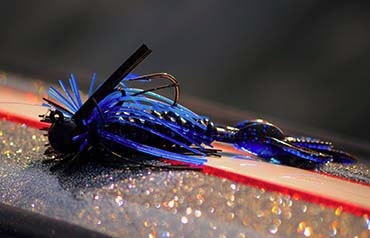 Cold weather and cold water can’t hold diehard bass fisherman Ty Spade back. The tournament competitor and Smithwick ambassador lives in central Pennsylvania, where winter weather often clogs his favorite reservoirs with ice. Yet, he still finds ways to scratch the angling itch.
Cold weather and cold water can’t hold diehard bass fisherman Ty Spade back. The tournament competitor and Smithwick ambassador lives in central Pennsylvania, where winter weather often clogs his favorite reservoirs with ice. Yet, he still finds ways to scratch the angling itch.
“When most places are iced over, I can still fish the upper Chesapeake Bay,” he said. “Or, sometimes I trailer my boat to Tennessee. But because they’re so close and convenient, I most often fish the Susquehanna and Juniata rivers.”
His lures of choice are a trifecta of winning winter smallmouth baits—a jerkbait, a tube bait and a small jig.
The Juniata River, his preference because it sees less fishing pressure, is quite shallow in the late season, prompting the angler to switch to his smaller, aluminum jet boat. “During the winter the deepest water you’ll see on the river is 5 or 6 feet, and that’s where you’ll find smallmouths.”
Thus, his go-to jerkbait is a Suspending Super Rogue Jr. “It dives to about 6 feet on a cast,” he explained, “but I don’t want it to run below the fish, so instead of using 6-pound line I fish it on a 10-pound fluoro.” The line’s wider diameter keeps the lure at about 4 feet, he said, and because it stretches less than mono, fluorocarbon better transmits a cold-water smallmouth’s less-aggressive strike.
Spade looks for deeper holes where the flow is just fast enough to create seams or eddies. “Smallmouths are lethargic now and won’t want to fight heavy current, but they’ll still use current breaks as ambush points. I fish along the breaks with a twitch-pause retrieve,” he explained, “and I don’t feel like I have to use a super long pause; I’ll stop it for, say, 6 to 10 seconds, then decide whether I have to slow down or speed up based on the fish’s reaction. That’s what’s so great about a jerkbait; you can fish it slower than a tube or faster than a crankbait.”
The angler strongly believes that reading a bass’ mood is more important than following a set procedure. “The cold water/long pause theory is a good rule-of-thumb, but don’t allow yourself to get locked into it,” he said. “I’ve caught smallmouths while burning a jerkbait in 40-degree water. On the other hand, there have been times when they didn’t bite so well on a slow-moving bait. That’s when I switch to dragging a tube or jig. Just pay attention to what they want and you’ll catch more fish.”
While Spade may resort to a tube or jig when a jerkbait falters, they become first-string players in holes that feature a rocky (chunk rock up to boulder size) bottom. “And don’t go too heavy,” he cautioned. A YUM Tube on a ¼-ounce, or lighter, jig head and a 3/8-ounce Finance Jig with a Wooly Bug trailer are just about perfect. “You don’t need a lot of action,” he said. “Just drag it along bottom; adding a few small hops if you want.” If snags are a problem, try a football-head Pigskin Jig.
The water you fish may not be as skinny as what Spade faces during the winter, but his techniques with this winning trifecta are still rock solid. Go with a larger jerkbait and heavier jig heads and reap the rewards.
